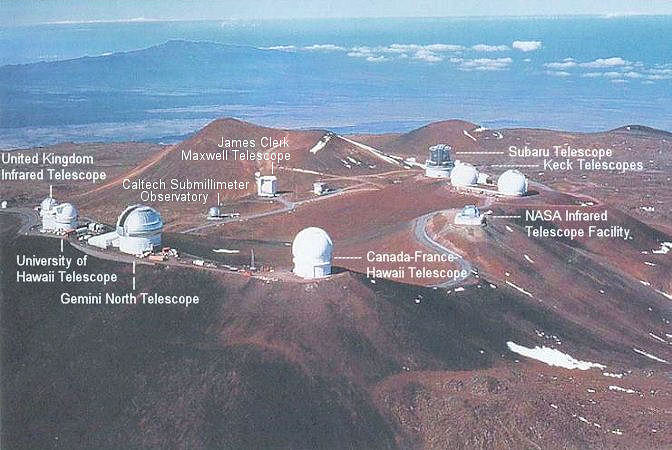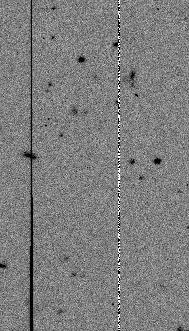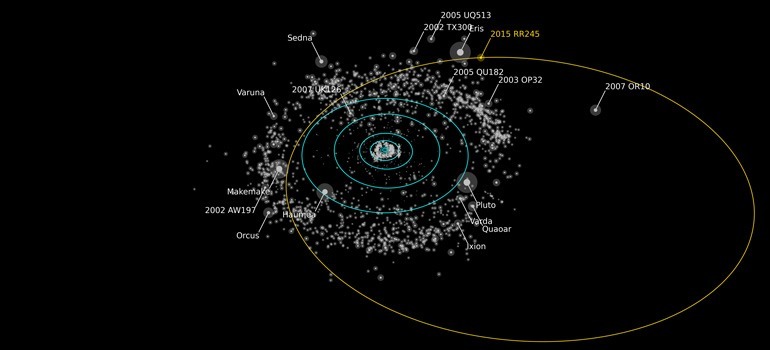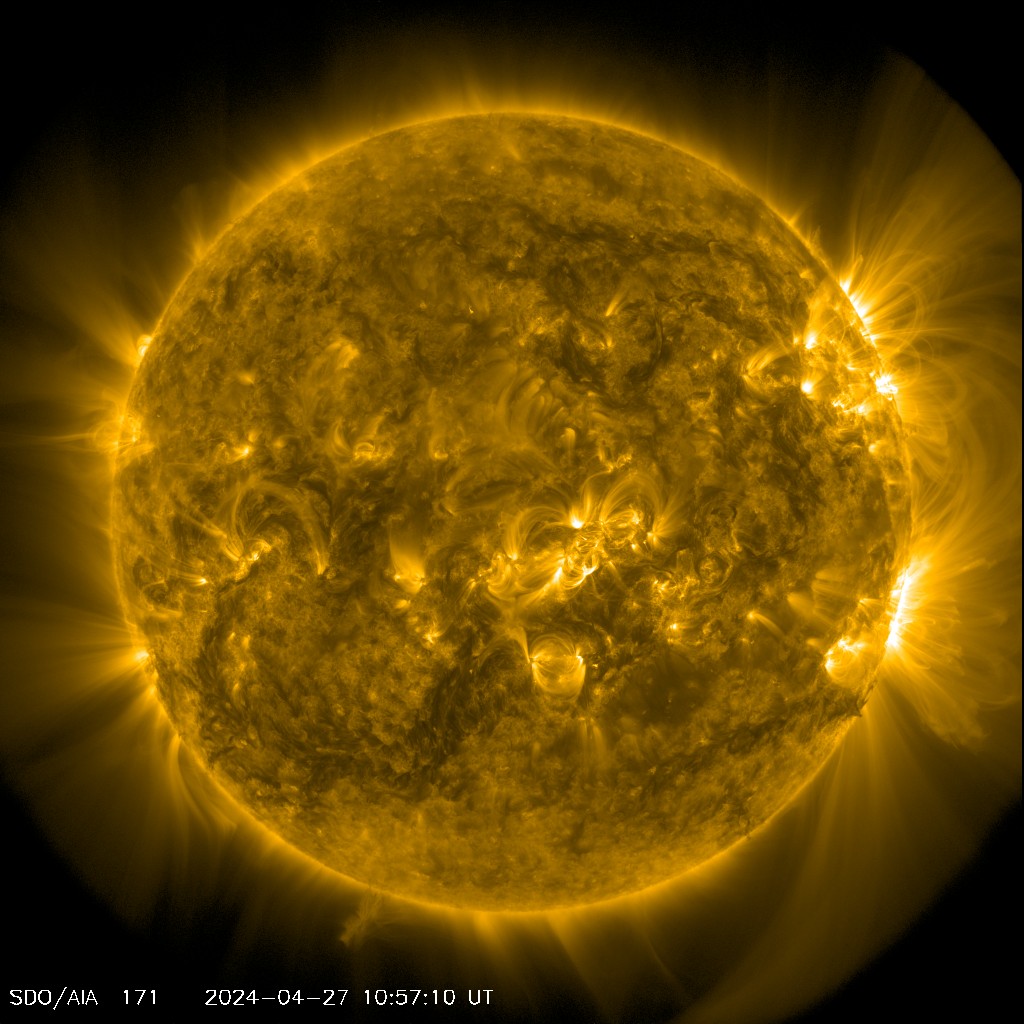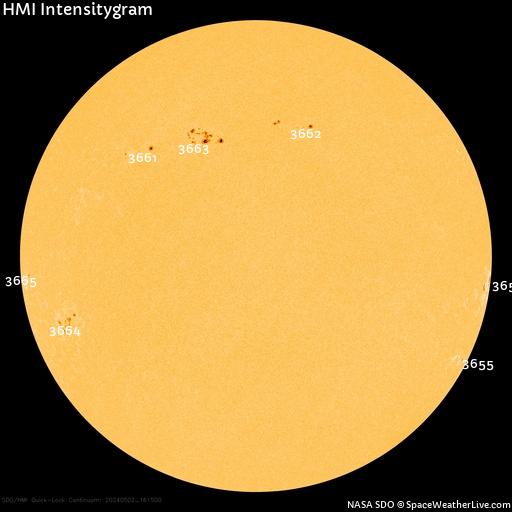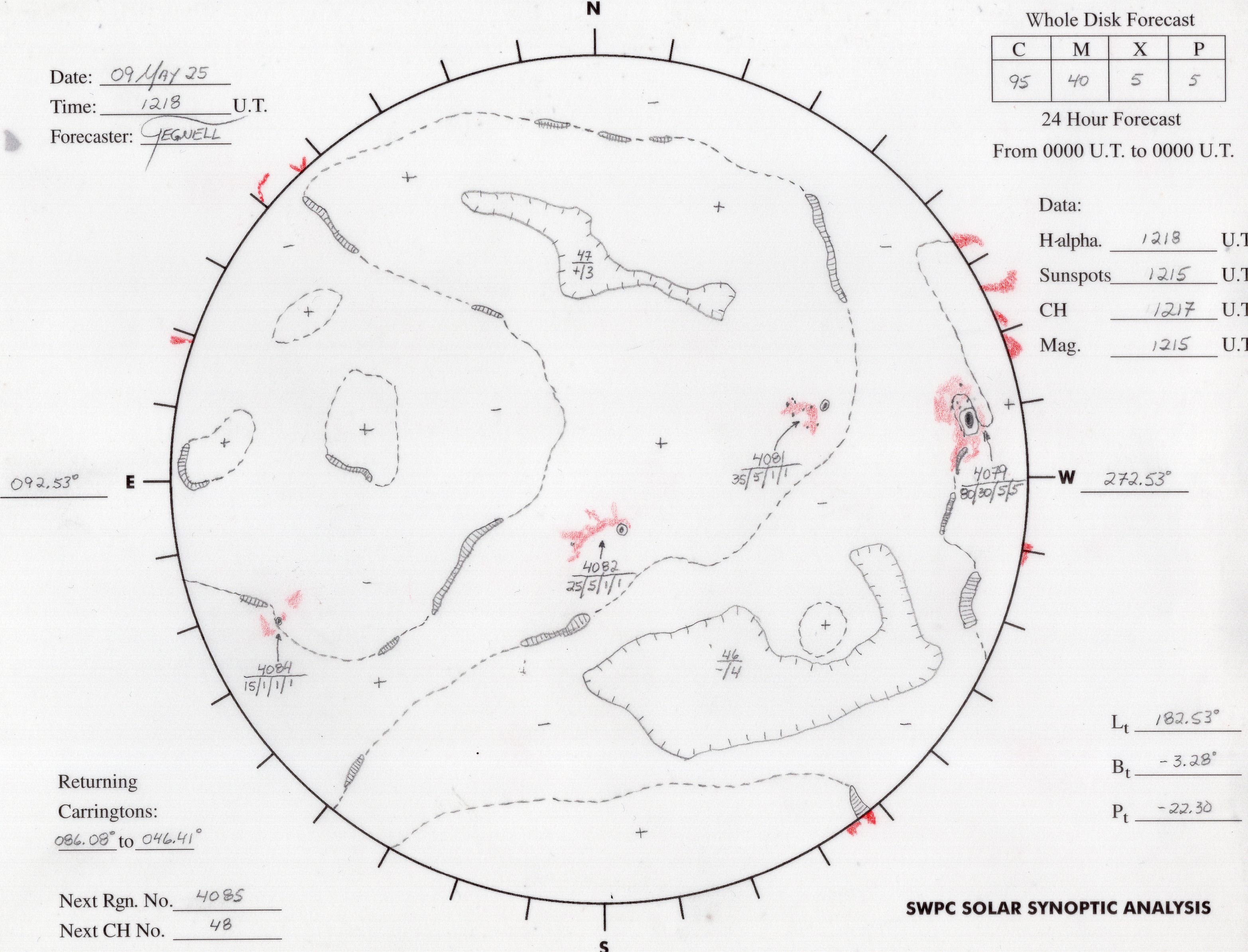 Un equipo internacional de astrónomos ha descubierto un nuevo planeta enano que orbita en el disco de pequeños mundos helados más allá de Neptuno. Fue descubierto por el Telescopio Canadá-Francia-Hawaii (arriba) en Maunakea, Hawaii (Ver figura inferior: Observatorio de Mauna Kea). Se aprecia el manto de nubes a unos mil metros de altura sobre el Océano Pacífico. Crédito: CFHT.
Un equipo internacional de astrónomos ha descubierto un nuevo planeta enano que orbita en el disco de pequeños mundos helados más allá de Neptuno. Fue descubierto por el Telescopio Canadá-Francia-Hawaii (arriba) en Maunakea, Hawaii (Ver figura inferior: Observatorio de Mauna Kea). Se aprecia el manto de nubes a unos mil metros de altura sobre el Océano Pacífico. Crédito: CFHT.
Un equipo internacional de astrónomos que incluye a investigadores de la Universidad de British Columbia (UBC) han descubierto un nuevo planeta enano que orbita en el disco de pequeños mundos helados más allá de Neptuno.
El nuevo objeto está a unos 700 kilómetros de diámetro- más o menos una vez y media el tamaño de Vancouver Island- y tiene una de las más grandes órbitas para un planeta enano. Designado como RR245 2015 por el Centro de Planetas Menores de la Unión Astronómica Internacional, se detectó con el Telescopio Canadá- Francia-Hawaii en Maunakea, Hawai, como parte de la Encuesta continua exterior del Sistema Solar Orígenes (Ossos).
“Encontrar un nuevo planeta enano más allá de Neptuno arroja luz sobre las primeras etapas de la formación de planetas”, dijo Brett Gladman, de la Cátedra de Investigación en Astronomía Planetaria en la UBC. “Dado que la mayoría de estos mundos helados son increíblemente pequeños y débiles (difíciles de ver), es emocionante poder encontrar uno brillante que es más fácil de estudiar, y que está en una órbita interesante.”
Imágenes del descubrimiento de RR245.Las imágenes muestran a cámara lenta a RR245 por el cielo en tres horas.Crédito: Ossos
RR245 fue visto por primera vez en febrero del 2016 por el Astrónomo JJ Kavelaars del Consejo Nacional de Investigación de Canadá. El proyecto Ossos utiliza potentes ordenadores para cazar las imágenes y a Kavelaars se le presentó un objeto brillante en movimiento a una velocidad tan lenta que indicaba claramente que se hallaba al menos dos veces más lejos de la Tierra que Neptuno y 120 veces más lejos del Sol que la Tierra.
El tamaño exacto de RR245 todavía no es conocido en forma precisa, ya que para definir sus propiedades superficiales se necesitan más medidas.
“El es pequeño y brillante, o bien, grande y opaco”, dijo Michele Barandilla de la Universidad de Victoria, estudiante postdoctoral con el Ossos.
La gran mayoría de los planetas enanos como RR245 fueron destruidos o lanzados fuera del Sistema Solar cuando los planetas gigantes se movieron a sus posiciones actuales. RR245 es uno de los pocos planetas enanos que sobrevivieron hasta nuestros días, junto con Plutón y Eris, los mayores planetas enanos conocidos. RR245 ha dado la vuelta al Sol entre la población remanente de decenas de miles de mundos transneptunianos mucho más pequeños, la mayoría de los cuales órbitan en esa región pero no son visibles.
Estos mundos que orbitan lejos del Sol tienen una geología exótica con paisajes hechos de muchos materiales diferentes congelados, como mostró el reciente sobrevuelo de Plutón por la nave espacial New Horizons. RR245 ha estado en una órbita altamente elíptica durante al menos los últimos 100 millones de años. Después de cientos de años a más de 12 mil millones de km (80 unidades astronómicas, AU) del Sol, RR245 viaja hacia su aproximación más cercana a cinco mil millones de kilómetros (34 UA), que alcanzará en torno al 2096.
Como RR245 sólo se ha observado en uno de los 700 años que tarda en orbitar alrededor del Sol, de dónde viene y cómo evolucionará su órbita lentamente en el futuro lejano aún se desconoce. Su órbita precisa será refinada en los próximos años, después de lo cual a RR245 se le dará un nombre. Como descubridores, el equipo Ossos puede presentar su nombre preferido para el RR245 a la Unión Astronómica Internacional para su consideración.
El RR245 es el mayor descubrimiento y el único planeta enano encontrado por Ossos, que ha descubierto más de quinientos nuevos objetos transneptunianos. El descubrimiento sólo fue posible debido a las excepcionales capacidades de observación del telescopio Canadá-Francia-Hawai (CFHT).
Representación de la órbita de RR245 (línea naranja). Objetos como brillante o más brillante que RR245 están etiquetados. El Centro de Planetas Menores describe el objeto como el 18 avo más grande en el cinturón de Kuiper. Crédito: Alex Parker, Ossos
Antecedentes.
El programa de Investigación Orígenes del Sistema Solar Exterior implica una colaboración de cerca de 50 científicos en los institutos y universidades de todo el mundo. Ossos se basa en observaciones obtenidas con MegaPrime / MegaCam, un proyecto conjunto del telescopio Canadá-Francia-Hawai (CFHT) y CEA / DAPNIA, y en los datos producidos y alojados en el Centro de Datos de Astronomía Canadiense.El CFHT es operado por el National Research Council de Canadá, el Instituto Nacional de las Ciencias del Universo del Centro Nacional de Investigación Científica de Francia, y la Universidad de Hawái, recibiendo Ossos acceso adicional debido a las contribuciones del Instituto de Astronomía y Astrofísica, Academia Sinica, Universidad Nacional Tsing Hua, y Consejo Nacional de Ciencia, Taiwán.
Fuente: Univ. of British Columbia. Artículo original: “Astronomers discover new distant dwarf planet beyond Pluto“.
Selección y traducción: Equipo de Redacción Web de la AAA.
El material relacionado fue proporcionado por el Equipo de Biblioteca de la AAA.
Material relacionado:
Objetos Transneptunianos (TNOs):
- Wikipedia/Objeto Transneptuniano. La versión en Inglés es más completa: Wikipedia/Trans-Neptunian Objects.
- Wikiwand/Objeto TransnepWtuniano. Wikiwand/Trans-Neptunian Object.
- Wikipedia/List of Solar System objects most distant from the Sun in 2015.
- Cansanchi/Objetos Transneptunianos, Revolución en el Sistema Solar, Pablo Santos, IAA-CSIC.
- ESO/The Messenger/The Outer Frontiers of the Solar System:Trans-Neptunian-Objects and Centaurus.
- ESA/Herschel’s Population of Trans-Neptunian Objects.
- Trans-Neptunian Objects, capítulo del libro: ”Dawn of Small Worlds”, Moltenbrey, Michael, Springer, 2016.
- Univ. de Granada e IAA_CSIC/Tesis Doctoral/Estudio fotométirco de Objetos Transneptunianos y Centauros,Pablo Santos Sanz, 2009. En el Capítulo 2 se hace una descripción completa de estos objetos.
- The Open University/TNOs are cool: a survey of the Transneptunian region, varios autores, 2009.
- *FCAG–UNLP/Seminario de Postgrado/El Espacio Transneptuniano, Dr. Adrián Brunini, Dra. Romina Di Sisto, 2007.
Cinturón de Kuiper:
- NASA/JPL/Kuiper Belt and Oort Cloud.
- ESO/Kuiper Belt and Oort Cloud, Summary Information Sheet.
- JHUAPL/New Horizons/The Kuiper Belt.
- The Nine Planets/The Kuiper Belt and The Oort Cloud.
- NASA/Views of The Solar System/ The Kuiper Belt.
- Phys.org/What is the Kuiper Belt?.
- Scientific American/The Kuiper Belt, byDr. Jane X. Luu and Dr.David C. Jewitt.
- UCLA, EPSS/ The Kuiper Belt: What we Know and What we don’t Know, Dr. D. Jewitt, Septiembre, 2012.
- American Institute of Physics/Physics Today/The Kuiper Belt, Dr. Michael E. Brown,UCLA, 2004.
- CalTech/The Largest Kuiper Belt Objects, Dr. Michael E. Brown, UCLA.
- Springer/El artículo “The Kuiper Belt”, Dr. Jane Luu en Asteroids, Comets and Meteors.
- OMNICS/Open Access Articles/ Kuiper belt.
- Pluto and The Kuiper Belt, Emily Lakdawalla(The Planetary Society).
Artículos y Papers:
- Universe Today/The Dark Energy Survey begins to reveal previously unknown Trans-Neptunian Objects.
- Scientific American/Kuiper Belt Missions could reveal the Solar System’s origins, by Michael D. Lemonick, November 1, 2014.
- Beyond the Kuiper Belt. (Inner Oort Cloud), Dr. Scott S. Sheppard.
- Astrobiology Magazine/The Kuiper Belt at 20: Paradigm Changes in Our Knowledge of the Solar System.
- Nature/Kuiper-belt interlopers, A. Morbidelli & H. F. Levison, 2003. (Disponible en Timbó).
- Nature/Conveyed to the Kuiper belt, Rodney Gomes, 2003. (Disponible en Timbó).
- Univ. of Arizona Press/Physical Nature of The Kuiper Belt, Dr. Jane X. Luu and Dr. David C. Jewitt.
- Nature/The formation of the Kuiper Belt by the outward transport of bodies during Neptune’s migration,Dr. Levison, Dr. Morbidelli.
- Springer/Earth, Moon and Planets /Accumulation and migration of the bodies from the zone of giant planets, disponible en Timbó. También puede verlo aquí.
- Astronomy and Astrophysics Journal/Kuiper Belt Evolution due to dynamical friction,Del Poppolo, Spediccato y Gamberra,1999.
- The Kuiper Belt and the Primordial evolution of the Solar System, M. Brown (UCLA), A. Morbidelli (Observ. de la Cote d’Azur).
- AAAS, Science Magazine/The Kuiper Belt and the Solar System’s Comet Disk, Brett Gladman. Disponible en Timbó.
- Kuiper Belt and Comets: An Observational Perspective, D. Jewitt
- Harvard Smithsonian Center for Astrophysics (CFA)/ NASA’s Hubble Harvests Distant Solar System Objects.
- Globedia/Resonancias orbitales en los objetos del Cinturón de Kuiper.
- The General Science Journal/The Planet Migration Hypothesis: Saving the Paradigm, Anthony J. Abruzzo, M.Phil
- Scientific American /Migrating Planets, Renu Malhotra.
- Scientific American/ Where Everything Is in the Solar System, Right Now, by Caleb A. Scharf on January 29, 2016
- CFEPS/Disccovery of the Trans-Neptunian object 2008KV_42.
Algunos proyectos de sondeo de TNOs
- OSSOS, Origins Survey.
- Kluwer Academic Publishers/Initial results for The Southern Edgeworth-Kuiper belt Survey (SEK), Rachel Moody and Brian Schmidt et al
- arXiv/A Southern Sky and Galactic Plane Survey for Bright Kuiper Belt Objects,Scott S. Sheppard, Andrzej Udalski et al
- SAO/NASA Astrophysics Data System/ Kuiper Belt Objects: Observing, From an Amateur’s Perspective, Offutt, W. B.
- RECON/Measure TNOs
La contribución de los amateurs:
- Blog: Simulating the Universe/How amateurs astronomers helped the New Horizons Team.
- Starship Asterisck/ Citizen Scientists: Discover a New Horizons Flyby Target.
- The Planetary Society/Finally, New Horizons has a new target, Emily Lakdawala.
Sobre la descategorización de Plutón como planeta y la nueva categoría de planetas enanos:
- Portal Uruguayo de Astronomía, Charlas/De 9 a 12 y finalmente 8. ¿Cuántos planetas hay alrededor del Sol?, Dr. Gonzalo Tancredi, 2007.
- Depto. Astronomía, Fac. Ciencias, Montevideo, Uruguay/Which are the Dwarfs in the Solar System?, G. Tancredi, S. Favre.
- Sky & Telescope, 112:5, Noviembre 2006, pp34 – 39/ Losing it in Prague: The Inside Story of Pluto’s Demotion, Owen Gingerich.
- Caltech Division of Geological and Planetary Sciences/The Dwarf Planets, Michael Brown.
Sobre el posible Planeta 9:
- Asociación de Aficionados a la Astronomía/Planeta 9. Es la colección de artículos publicados sobre el tema. En particular en el artículo:”Los objetos transneptunianos guían hacia el Planeta 9“,en el “material relacionado” se encuentra una colección completa de artículos sobre los sucesivos descubrimientos de objetos transneptunianos.
Todos los artículos y papers publicados tanto en Nature, Science, Scientific American, Physics Today y en la gran mayoría de los Journals los encuentra en Timbó.
- Los Angeles Times/Kuiper Belt News.
Presentaciones:
- University of Wien/Kuiper Belt, Oort Cloud and TNOs, Gerhard Weihs.
- Saint Mary’s Univ., ICA/The Kuiper Belt and the early evolution of the Outer Solar System, Joseph M. Hahn.
- SSI/Sculpting The Kuiper Belt via Neptune’s orbital migration, Joseph M. Hahn, Renu Malhotra.
- ICRANET/International program of stellar occultations by TNOs, Aosta Valley Astronomical Observatory.
- RECON/Measure TNOs
Observatorio CFHT en Mauna Kea:
- Canada France-Hawaii Telescope.
- Univ. of Hawaii, Institute for Astronomy/Mauna Kea Observatories.
- UNESCO Astronomical Heritage/Mauna Kea Observatory.
- Hilo Living/World Class Astronomy in Hawaii.
- CFHT/MegaPrime/MegaCam.
- Astro WISE Instruments.
- SPIE/The next generation of the Canada-France-Hawaii-Telescope: science requeriments and survey strategies.
Libros: (Todos los libros de Springer menos el primero están disponibles en Timbó).
- Dawn of Small Worlds, Moltenbrey, Michael, Springer, 2016.
- Beyond Pluto: Exploring the outer limits of the Solar System,John Davies (Cambridge, 2001) cuenta la historia del descubrimiento del Cinturón de Kuiper y de los
- The Hunt for Planet X: New worlds and the fate of Pluto,Govert Schilling cuenta la historia del descubrimiento del Sistema Solar Exterior comenzando desde el descubrimiento de Urano y los asteroides. Springer,2009. Disponible en Timbó.
- How I Killed Pluto: And why it had it coming, Mike Brown libro excelente, muy entretenido.(Véa abajo el Video).
- The Pluto Files: The Rise and Fall of America’s Favorite Planet. Neil deGrasse Tyson. W. W. Norton, 2009.(Véa abajo el Video).
- Data Book of Astronomy, Patrick Moore & Robin Rees, Cambridge UP, 2011
- An Introduction to the Solar System,D. Rothery, Neil McBride & Iain Gilmour (eds), The Open University/Cambridge UP, 2011.
- Asteroids and Dwarf Planets and How to Observe Them, Roger Dymock, Springer,2010.
- At the Edge of the Solar System: Icy New Worlds Unveiled, Authors: Doressoundiram, A., Lellouch, E., Springer,2010.
- The Solar System Beyond Neptune, editores: Barucci, Boehnhardt, Cruikshank, Morbidelli, Univ. of Arizona Press-Tucson and LPI-Houston, 2008; de nivel académico y con la colaboración de 101 científicos, reúne en un sólo volumen el estado del arte a la fecha de su publicación.
- The Solar System, Encrenaz, T., Bibring, J.-P., Blanc, M., Barucci, M.-A., Roques, F., Zarka, P., Springer, 2004.
Páginas Web de algunos de los principales investigadores de TNOs:
- Lynne Allen
- Bary Bernstein
- Mike E. Brown
- Marc Buie
- John Davies
- Martin Duncan
- Will Grundy
- Dave Jewitt
- Gary Kronk
- Hal Levison
- Joel Parker
- Bill Romanishin
- John Stansberry
- Alan Stern
- Steve Tegler
- Christian Veille
Páginas Web relacionadas al Cinturón de Kuiper
- Distant EKOs newsletter
- A glossary of acronyms and terms used in Kuiper belt research.
- Services provided by the IAU’s Central Bureau for Astronomical Telegrams (CBAT):
- The ephemerides and orbital elements of comets, minor planets, NEOs, etc.
- Lists (and orbital elements) of TNOs and Centaurs
- Info and archive of the IAU Circulars (IAUCs) and the Minor Planet Electronic Circulars (MPECs)
- The New Horizons Pluto-Kuiper Belt mission: links at APL and SwRI
- The TAOS (The Taiwan-American Occultation Survey) Project
- The TNO Recovery Program at CFHT.
- COMPLEX report on Exploring the Trans-Neptune region
- Some general info about the Kuiper belt and related objects from Bill Arnett’s Tour of The Solar System.
- Some images from the Views of the Solar System page by Calvin Hamilton.
- Mike Brown’s Planets: https://www.mikebrownsplanets.com/
- Marc Buie’s Kuiper Belt page
- Dave Jewitt’s Kuiper Belt page
- Bill Romanishin’s Kuiper Belt and general observation page.
- Laurel Kornfeld’s Pluto Blog
Videos:
- N-G/Plutón y más allá.
- Documental Odisea/ Plutón: La Última Frontera.
- IAA-CSIC /Más allá de Neptuno: Los Confines del Sistema Solar,Dr. Pablo Santos.
- IAA-CSIC/Los Enanos del Sistema Solar, Dr. René Duffard.
- Universe/How the Solar System was made?. Documental
- The Universe/Kuiper Belt Objects and Io, Europa & Triton. Documental.
- The Solar System most Distant Worlds, Documental.
- New Horizon Spacecraft Mission – First Pluto Direct Encounter. Documental 2015.
- The Sky at Night/ Pluto Revealed. Documental.
- The Royal Society, Kavli Prize Laureate lecture/The Kuiper Belt and its implications, Professor Dr. Jane Luu.
- Carnegie Institution/Pluto, Eris and the Dwarf Planets of the Outer Solar System, Dr.Michael Brown,CalTech.
- SVAstronomyLectures/How I killed Pluto and What It Had It Coming, Dr.Michael Brown, CalTech.
- The Pluto Files, Neil deGrasse Tyson, Documentary.
- FORA TV/The Pluto Files, Neil deGrasse Tyson, interview.
- csuDHTV and The Planetary Society/ Transneptunian Objects (TNOs) including the Pluto System, Eris, Kuiper Belt Objects, Comets, and the Oort Cloud, Astronomy with Bruce Betts.
- NASA/Planetary Exploration, Passport to Pluto Charon and Kuiper Belt Trans-Neptunian Region.
- NASA/NASA’s New Horizons Spacecraft: Seeing Pluto as Never Before.
- SVAstronomyLectures/Report from the Planetary Frontier: The Latest from New Horizons at Pluto, Dr. Jeff Moore (NASA Ames Research Center).
- Lunar and Planetary Institute/Public Lecture: The Exploration of Pluto, Dr. Alan Stern.
- Hubble Space Telescope Science Institute/The Exploration of Pluto and the Kuiper Belt by NASA’s New Horizons Mission
- Carnegie Science’s Department of Terrestrial Magnetism,The Exploration of Pluto and the Kuiper Belt by New Horizons , Dr. Hal Weaver, JHUAPL
- MIT EAPS Lecture/”Pluto Revealed: Latest Results from NASA New Horizons Mission“, Professor Richard P. Binzel.
- Lunar and Planetary Institute/Special Session: Planet 9 from Outer Space – Pluto Geology and Geochemistry, Dr. J. Spencer
- SETI Talks /Pluto, the Kuiper belt and the early history of the solar system – Dr. Renu Malhotra.





